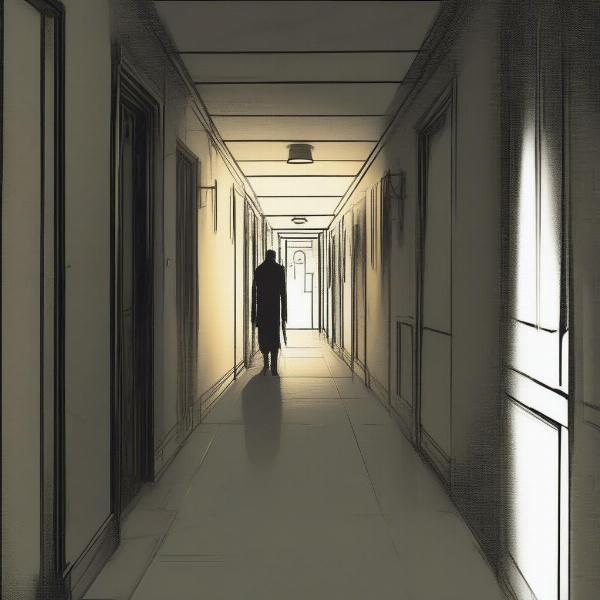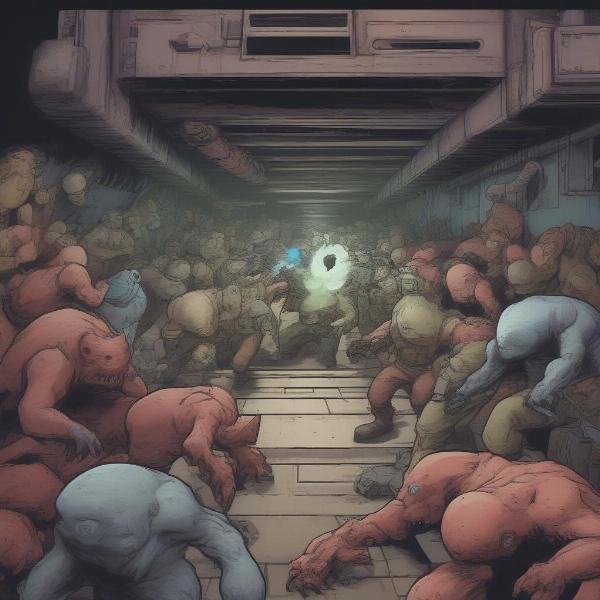What’s your biggest fear game? The horror genre thrives on exploiting our deepest anxieties, crafting experiences that tap into our primal fears. From jump scares to psychological thrillers, the gaming world offers a diverse range of terrifying experiences. This article explores the psychology behind why we enjoy being scared, examines the different types of fear games employ, and delves into some of the most terrifying titles that have left a lasting mark on the gaming landscape.
The Thrill of the Chill: Why We Love Fear Games
Why do we willingly subject ourselves to these digital nightmares? The answer lies in the complex interplay of psychological and physiological responses that fear evokes. The adrenaline rush, the heightened senses, the feeling of vulnerability – these are all part of the appeal. It’s a controlled environment where we can experience the thrill of danger without actual risk. It’s like a rollercoaster, a safe space to experience extreme emotions. Our brains release dopamine and endorphins during these experiences, contributing to a sense of euphoria after the initial fear subsides. This “fight-or-flight” response, while initially stressful, can be strangely enjoyable when experienced within the safe confines of a game.
Furthermore, fear games often present us with compelling narratives and challenging puzzles that engage our problem-solving skills. The sense of accomplishment derived from overcoming in-game obstacles, coupled with the adrenaline rush of fear, creates a unique and rewarding experience. The psychological tension, the anticipation of the unknown, these elements keep us on the edge of our seats, eager to uncover what lurks around the next corner.
 Psychological Horror Game Evoking Fear and Anxiety
Psychological Horror Game Evoking Fear and Anxiety
Different Flavors of Fear: Exploring Horror Game Subgenres
The horror genre is not monolithic. It encompasses a variety of subgenres, each targeting specific fears and anxieties. From the visceral terror of survival horror to the creeping dread of psychological thrillers, there’s a fear game out there for everyone (or perhaps, everyone’s worst nightmare).
Survival Horror: Resource Management and Claustrophobic Terror
Survival horror games, like Resident Evil and Silent Hill, focus on resource management and vulnerability. Ammo is scarce, enemies are relentless, and the environments are designed to induce claustrophobia. These games often emphasize puzzle-solving and exploration, adding a layer of intellectual challenge to the heart-pounding action.
Psychological Horror: Mind Games and Unsettling Atmospheres
Psychological horror games, like Silent Hill 2 and Amnesia: The Dark Descent, delve into the depths of the human psyche. They prey on our insecurities and anxieties, creating an atmosphere of unease and dread. These games often utilize psychological manipulation, unsettling sound design, and mind-bending narratives to create a truly disturbing experience. They mess with your head, leaving you questioning what’s real and what’s not.
Jump Scares: The Cheap Thrill
While often criticized for being a cheap tactic, jump scares undeniably have their place in the horror genre. They’re the equivalent of a sudden, sharp intake of breath, a momentary spike of adrenaline. Games like Five Nights at Freddy’s have effectively utilized jump scares to create a sense of constant tension and paranoia.
 Survival Horror Game Highlighting Resource Scarcity and Fear
Survival Horror Game Highlighting Resource Scarcity and Fear
What Makes a Game Truly Terrifying? The Elements of Fear
What are the key ingredients that make a game truly terrifying? It’s a combination of factors, from the narrative and atmosphere to the sound design and gameplay mechanics. A well-crafted horror game utilizes these elements to create a sense of immersion and dread.
-
Atmosphere: The setting, lighting, and sound design all contribute to the overall atmosphere of a game. A dark, oppressive environment with unsettling ambient noises can be far more effective than a sudden jump scare.
-
Sound Design: The subtle creak of a floorboard, the distant whisper of a voice, these auditory cues can be incredibly effective in building tension and creating a sense of unease. Sound design is often the unsung hero of horror games.
-
Storytelling: A compelling narrative can elevate a horror game from a simple scare-fest to a truly memorable experience. A well-written story can create emotional investment in the characters and the world, making the scares all the more impactful.
-
Psychological Manipulation: Games that delve into the psychology of fear are often the most effective. By playing on our insecurities and anxieties, these games can create a truly unsettling experience.
“A truly terrifying game isn’t just about jump scares,” says Dr. Emily Carter, a renowned psychologist specializing in the impact of media on the human psyche. “It’s about creating an atmosphere of dread, of psychological unease. It’s about making the player feel vulnerable, exposed.”
A Descent into Darkness: Exploring Iconic Fear Games
Let’s explore some of the most terrifying games that have left an indelible mark on the gaming community:
-
Silent Hill 2: This psychological masterpiece explores themes of guilt, grief, and repressed trauma, creating a deeply unsettling and emotionally resonant experience.
-
Amnesia: The Dark Descent: This first-person survival horror game strips the player of any means of defense, forcing them to rely on stealth and wit to survive the horrors of Brennenburg Castle.
-
Resident Evil 7: Biohazard: This installment in the long-running franchise returned to the series’ roots, delivering a claustrophobic and visceral horror experience that harkened back to the original games.
-
Outlast: Armed with only a night vision camera, players must navigate a dilapidated asylum filled with deranged inmates, creating a truly terrifying experience of vulnerability and helplessness.
![]() Iconic Fear Games and Psychological Horror Elements
Iconic Fear Games and Psychological Horror Elements
Facing Your Fears: The Future of Horror Gaming
The future of horror gaming is bright (or perhaps, dimly lit). With advancements in virtual reality and augmented reality, the potential for immersive and terrifying experiences is greater than ever before. As technology continues to evolve, so too will the ways in which game developers can tap into our deepest fears.
FAQ: Your Burning Questions About Fear Games
-
Why do some people enjoy being scared? The adrenaline rush and the feeling of overcoming fear can be strangely enjoyable.
-
What are some common themes in horror games? Isolation, vulnerability, and the unknown are common themes in the genre.
-
What is the difference between survival horror and psychological horror? Survival horror focuses on resource management and physical threats, while psychological horror targets the player’s mind and emotions.
The Final Scare: Embracing the Thrill of Terror
What’s your biggest fear game? Ultimately, it depends on what scares you the most. Whether you prefer the visceral thrills of survival horror or the creeping dread of psychological thrillers, the gaming world offers a wealth of terrifying experiences. So, embrace the fear, and delve into the darkness. Just remember to keep the lights on.

